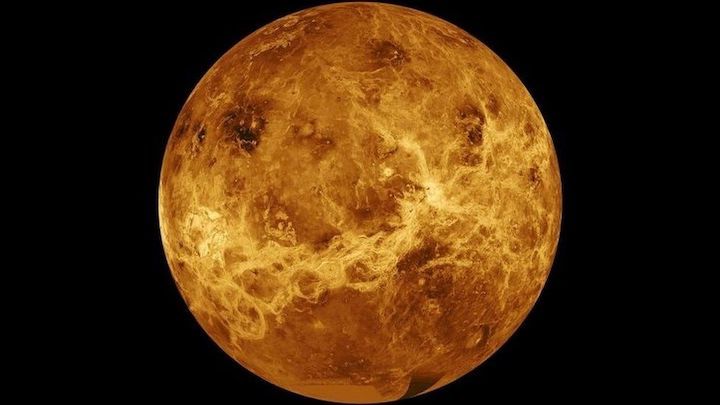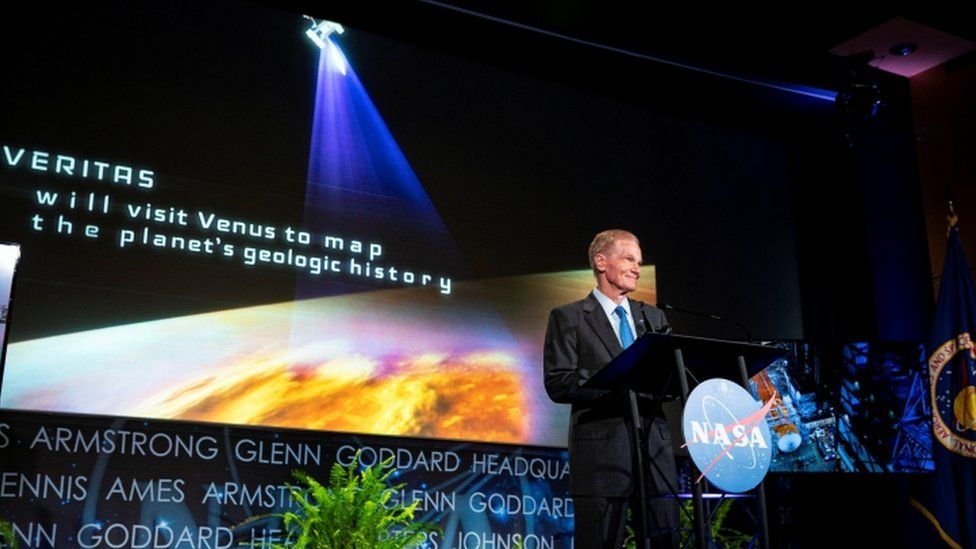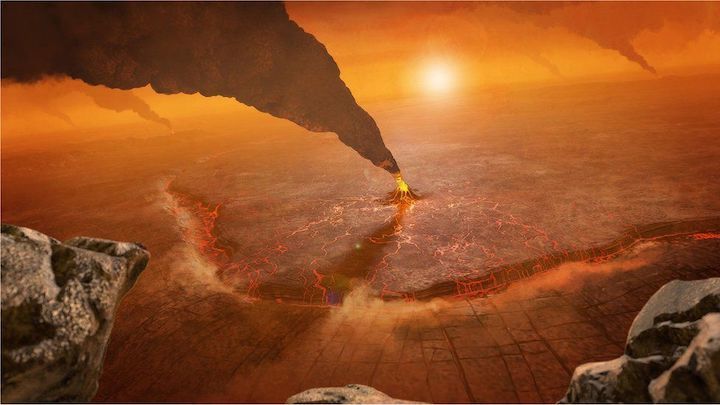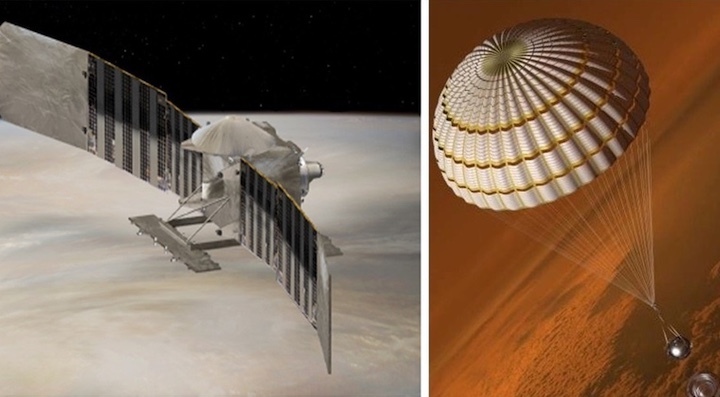4.06.2021

Nasa has announced that it is sending two new missions to Venus in order to examine the planet's atmosphere and geological features.
The missions, which have each been awarded $500m (£352m) in funding, are due to launch between 2028 and 2030.
Nasa administrator Bill Nelson said the missions would offer the "chance to investigate a planet we haven't been to in more than 30 years".
The last US probe to visit the planet was the Magellan orbiter in 1990.
However, other spacecraft - from Europe and Japan - have orbited the planet since then.
The missions were picked following a peer review process and were chosen based on their potential scientific value and the feasibility of their development plans.
 IMAGE COPYRIGHTREUTERS
IMAGE COPYRIGHTREUTERS"These two sister missions both aim to understand how Venus became an inferno-like world, capable of melting lead at the surface," Mr Nelson said.
Venus is the second planet from the sun and the hottest planet in the solar system with a surface temperature of 500C - high enough to melt lead.
The Davinci+ (Deep Atmosphere Venus Investigation of Noble gases, Chemistry, and Imaging) mission will measure the planet's atmosphere to gain insight into how it formed and evolved. It will also aim to determine whether Venus ever had an ocean.
Davinci+ is expected to return the first high resolution images of the planet's "tesserae" geological features. Scientists believe these features could be comparable to continents on Earth and could suggest that Venus has plate tectonics.
The second mission, Veritas (Venus Emissivity, Radio Science, InSAR, Topography, and Spectroscopy), will map the planet's surface to understand its geological history and investigate how it developed so differently than Earth.
It will use a form of radar to chart surface elevations and discover whether volcanoes and earthquakes are still happening.
"It is astounding how little we know about Venus, but the combined results of these missions will tell us about the planet from the clouds in the sky through the volcanoes on its surface all the way down to its very core," said Tom Wagner from Nasa's Planetary Science Division.
"It will be as if we have rediscovered the planet," he added.
A changing view of Venus
Analysis by Paul Rincon, Science Editor, BBC News website
Over the last few decades, Mars has dominated Nasa's budget for planetary missions. In the meantime, researchers studying Venus have become philosophical about the lack of priority given to their planet.
But that has been changing. New ideas, interpretations and new people have been transforming our understanding of Earth's nearest neighbour. Long thought to have been a "dead" planet by some, there are many who now think Venus may be geologically active, perhaps with periodic volcanism.
It may have harboured oceans for a billion years of its history, and there is even a region of the planet's thick atmosphere where microbial life could survive, floating among the clouds.
Scientists who have devoted their careers to studying this hothouse world are jubilant that the planet is finally back on Nasa's radar.

Artwork: Venus may have ongoing volcanism today
Quelle: BBC
+++
NASA Selects 2 Missions to Study ‘Lost Habitable’ World of Venus
NASA has selected two new missions to Venus, Earth’s nearest planetary neighbor. Part of NASA’s Discovery Program, the missions aim to understand how Venus became an inferno-like world when it has so many other characteristics similar to ours – and may have been the first habitable world in the solar system, complete with an ocean and Earth-like climate.
These investigations are the final selections from four mission concepts NASA picked in February 2020 as part of the agency’s Discovery 2019 competition. Following a competitive, peer-review process, the two missions were chosen based on their potential scientific value and the feasibility of their development plans. The project teams will now work to finalize their requirements, designs, and development plans.
NASA is awarding approximately $500 million per mission for development. Each is expected to launch in the 2028-2030 timeframe.
The selected missions are:
DAVINCI+ (Deep Atmosphere Venus Investigation of Noble gases, Chemistry, and Imaging)
DAVINCI+ will measure the composition of Venus’ atmosphere to understand how it formed and evolved, as well as determine whether the planet ever had an ocean. The mission consists of a descent sphere that will plunge through the planet’s thick atmosphere, making precise measurements of noble gases and other elements to understand why Venus’ atmosphere is a runaway hothouse compared the Earth’s.
In addition, DAVINCI+ will return the first high resolution pictures of the unique geological features on Venus known as “tesserae,” which may be comparable to Earth’s continents, suggesting that Venus has plate tectonics. This would be the first U.S.-led mission to Venus’ atmosphere since 1978, and the results from DAVINCI+ could reshape our understanding of terrestrial planet formation in our solar system and beyond. James Garvin of Goddard Space Flight Center in Greenbelt, Maryland, is the principal investigator. Goddard provides project management.
VERITAS (Venus Emissivity, Radio Science, InSAR, Topography, and Spectroscopy)
VERITAS will map Venus’ surface to determine the planet’s geologic history and understand why it developed so differently than Earth. Orbiting Venus with a synthetic aperture radar, VERITAS will chart surface elevations over nearly the entire planet to create 3D reconstructions of topography and confirm whether processes such as plate tectonics and volcanism are still active on Venus.
VERITAS also will map infrared emissions from Venus’ surface to map its rock type, which is largely unknown, and determine whether active volcanoes are releasing water vapor into the atmosphere. Suzanne Smrekar of NASA’s Jet Propulsion Laboratory in Southern California, is the principal investigator. JPL provides project management. The German Aerospace Center will provide the infrared mapper with the Italian Space Agency and France’s Centre National d'Etudes Spatiales contributing to the radar and other parts of the mission.
“We’re revving up our planetary science program with intense exploration of a world that NASA hasn’t visited in over 30 years,” said Thomas Zurbuchen, NASA’s associate administrator for science. “Using cutting-edge technologies that NASA has developed and refined over many years of missions and technology programs, we’re ushering in a new decade of Venus to understand how an Earth-like planet can become a hothouse. Our goals are profound. It is not just understanding the evolution of planets and habitability in our own solar system, but extending beyond these boundaries to exoplanets, an exciting and emerging area of research for NASA.”
Zurbuchen added that he expects powerful synergies across NASA’s science programs, including the James Webb Space Telescope. He anticipates data from these missions will be used by the broadest possible cross section of the scientific community.
“It is astounding how little we know about Venus, but the combined results of these missions will tell us about the planet from the clouds in its sky through the volcanoes on its surface all the way down to its very core,” said Tom Wagner, NASA’s Discovery Program scientist. “It will be as if we have rediscovered the planet.”
In addition to the two missions, NASA selected a pair of technology demonstrations to fly along with them. VERITAS will host the Deep Space Atomic Clock-2, built by JPL and funded by NASA’s Space Technology Mission Directorate. The ultra-precise clock signal generated with this technology will ultimately help enable autonomous spacecraft maneuvers and enhance radio science observations.
DAVINCI+ will host the Compact Ultraviolet to Visible Imaging Spectrometer (CUVIS) built by Goddard. CUVIS will make high resolution measurements of ultraviolet light using a new instrument based on freeform optics. These observations will be used to determine the nature of the unknown ultraviolet absorber in Venus’ atmosphere that absorbs up to half the incoming solar energy.
Established in 1992, NASA’s Discovery Program has supported the development and implementation of over 20 missions and instruments. These selections are part of the ninth Discovery Program competition.
The concepts were chosen from proposals submitted in 2019 under NASA Announcement of Opportunity NNH19ZDA010O. The selected investigations will be managed by the Planetary Missions Program Office at NASA’s Marshall Space Flight Center in Huntsville, Alabama, as part of the Discovery Program. The Discovery Program conducts space science investigations in the Planetary Science Division of NASA’s Science Mission Directorate. The goals of the program are to provide frequent opportunities for principal investigator-led investigations in planetary sciences that can be accomplished under a not-to-exceed cost cap.
Quelle: NASA
+++
NASA selects two Venus missions for Discovery program

WASHINGTON — For the first time in more than three decades, NASA has announced it will send a robotic mission to Venus, selecting two proposals in the latest round of its Discovery program.
NASA Administrator Bill Nelson announced at the end of a “State of NASA” speech at NASA Headquarters June 2 that the DAVINCI+ and VERITAS missions will launch to Venus in the late 2020s, having beat out competing proposals for missions to Jupiter’s volcanic moon Io and Neptune’s large moon Triton that were also selected as finalists in early 2020.
“These two sister missions both aim to understand how Venus became an inferno-like world capable of melting lead at the surface,” Nelson said. “They will offer the entire science community the chance to investigate a planet we haven’t been to in more than 30 years.”
DAVINCI+, or Deep Atmosphere Venus Investigation of Noble gases, Chemistry, and Imaging, will send a probe into the planet’s atmosphere, measuring noble gases and other elements that can provide information on how its runaway greenhouse effect developed. Cameras on the descent probe will provide high-resolution images of geological features known as “tesserae” that may be similar to Earth’s continents.
VERITAS, or Venus Emissivity, Radio Science, InSAR, Topography, and Spectroscopy, will map the planet from orbit using a synthetic aperture radar system. It will also search for infrared emissions that could help scientists determine if there is active volcanism.
“It is astounding how little we know about Venus, but the combined results of these missions will tell us about the planet from the clouds in its sky through the volcanoes on its surface all the way down to its very core,” said Tom Wagner, NASA’s Discovery program scientist, in a statement. “It will be as if we have rediscovered the planet.”
DAVINCI+ will be led by NASA’s Goddard Space Flight Center, while VERITAS will be run by the Jet Propulsion Laboratory. Lockheed Martin will build the spacecraft for both missions.
Each mission has an estimated cost of $500 million, with launches expected between 2028 and 2030. Launch contracts will be awarded later in each mission’s development.
In a briefing with reporters after the State of NASA speech, Thomas Zurbuchen, NASA associate administrator for science, said all four proposals, including the Io Volcano Observer and Trident mission to Triton, rated well. “This is not the case where one of these missions had a massively bigger risk. It’s not the case that one of them was ground-ruled out in some way,” he said.
While both DAVINCI+ and VERITAS are going to Venus, he noted that the two missions are “massively different” in their science, one focusing on the atmosphere and the other the surface. “In the end, those two swung, in terms of science return and programmatic match, to the top,” he said. “Those were the best missions, and that’s why we selected them.”
The two winning missions are updated versions of proposals that were finalists in the previous round of the Discovery program. NASA instead selected two asteroid missions, Lucy and Psyche, in early 2017.
Having been through the competition before helped DAVINCI+ and VERITAS. “I hardly recognized the proposal,” he said of VERITAS in particular. “The science was just so much better. The ratings were so much better than the previous round.”
Both missions will host technology demonstrations in addition to their primary science payloads. VERITAS will host an updated version of a deep space atomic clock first flown on an Earth-orbiting spacecraft in 2019 that will assist in radio science observations and autonomous spacecraft maneuvers. DAVINCI+ will fly a new ultraviolet imaging spectrometer.
The missions will be the first NASA missions dedicated to Venus since the Magellan radar mapper orbiter, launched in 1989. Magellan’s mission ended in 1994, and while scientists have been able to participate in European and Japanese Venus orbiter missions, or take advantage of limited observations by other spacecraft flying by Venus, many researchers had been advocating for years for a new Venus mission.
“In the science community, I can tell you, this is resonating,” Nelson said in the post-speech briefing. “They’re excited about this.”
Other countries and even private ventures are planning missions to Venus. Russia has been working for several years on a mission concept called Venera-D that includes an orbiter and lander, which could feature some NASA participation. India is developing a Venus orbiter mission called Shukrayaan scheduled for launch in 2024. The European Space Agency is considering a Venus orbiter called EnVision for its next medium-class mission.
Perhaps most intriguingly, Rocket Lab, the small launch vehicle and smallsat developer, has been leading efforts to send a small mission to Venus. That mission has been motivated in part by the potential discovery of phosphine in the planet’s atmosphere, a gas that could be evidence of life. Scientists announced in September 2020 the potential detection of phosphine based on analysis of ground-based infrared and microwave observations, but other scientists have questioned that detection.
Peter Beck, Rocket Lab’s chief executive, has said on numerous occasions that the company is working on a smallsat mission that would plunge into the atmosphere to search for phosphine or other biosignatures. That could launch as soon as 2023, although the company has provided few details about the mission’s development.
“Venus is the most underrated planet in our solar system,” he said during a May 27 webinar by Bessemer Venture Partners, citing the potential lessons from that planet’s runaway greenhouse that could apply to Earth. “I think we can learn a tremendous amount, scientifically, from Venus.”
Quelle: SN

